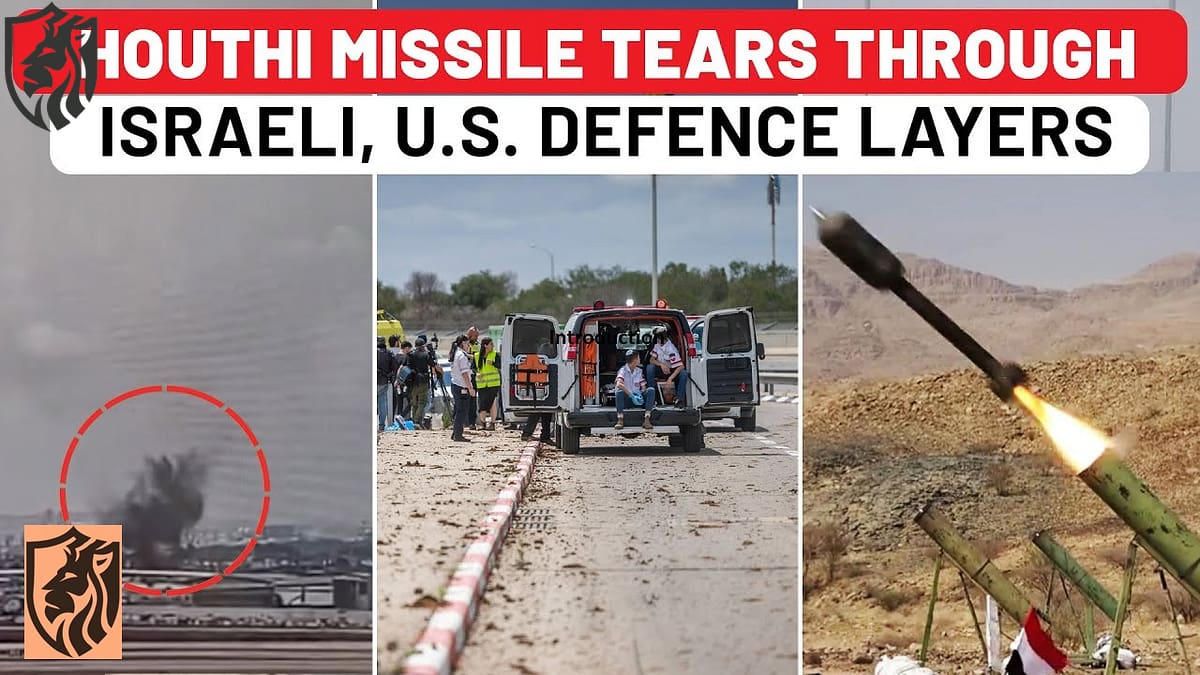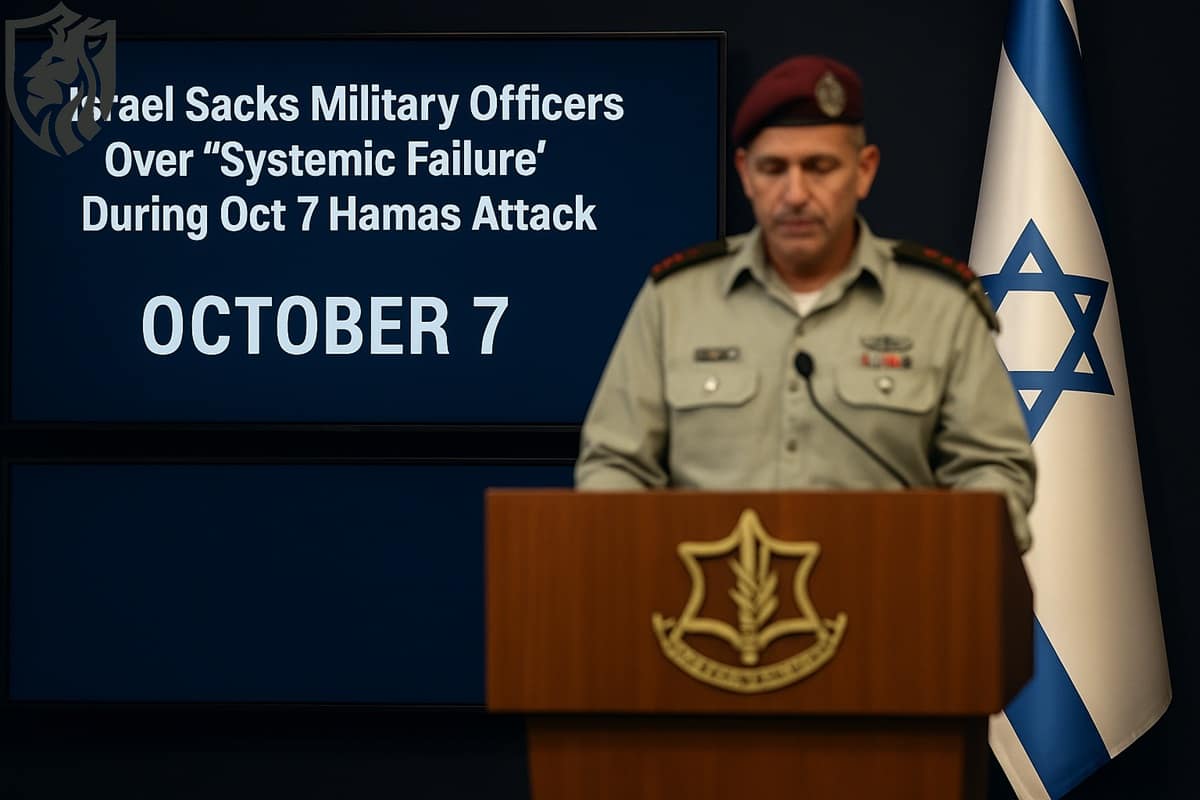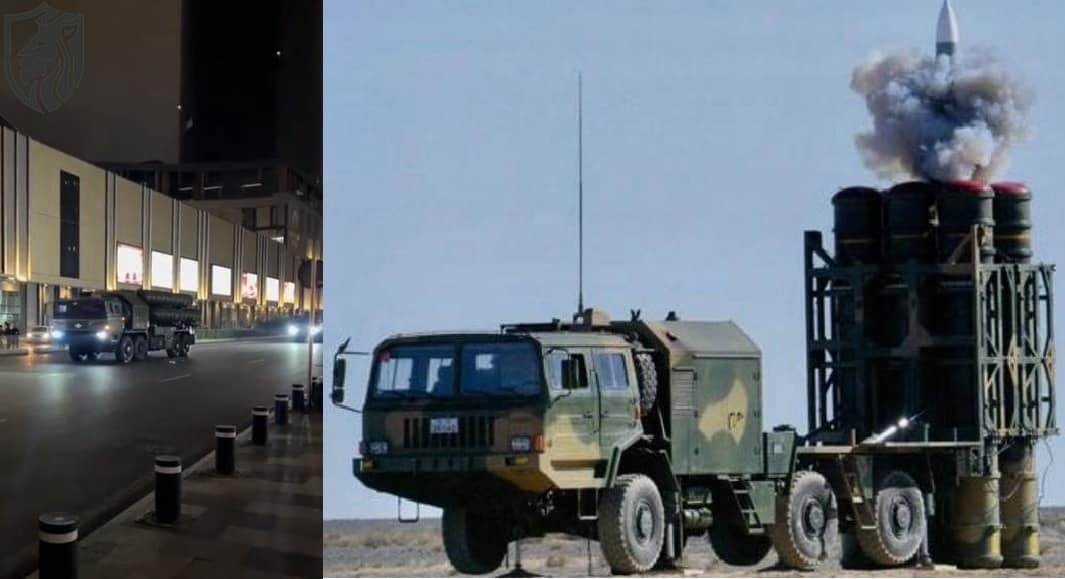
Houthi Missile Tears Through U.S. THAAD and Israeli Arrow Defense System
A missile slightly wrecked a road and a vehicle, injuring eight individuals, and activated air raid alarms throughout central Israel, temporarily suspending activity at the nation’s busiest airport. The Israel Defence Forces (IDF) confirmed that multiple attempts to destroy the projectile were unsuccessful, citing possible mechanical failure as the reason. Israeli media, meanwhile, reported that both systems engaged the target in an inadequate manner.
This unusual test raises questions regarding the effectiveness of these cutting-edge defences and the increasing danger posed by Houthi’s missile capabilities. The THAAD system, manufactured by Lockheed Martin, is capable of intercepting short-, medium-, and intermediate-range ballistic missiles in their terminal phase, within Earth’s atmosphere and outside.
Set up in Israel starting October 2024 to deal with rising regional threats, THAAD uses a “hit-to-kill” method, destroying incoming warheads by crashing into them at speeds over Mach 8 A typical THAAD battery includes six launchers on trucks, each holding eight interceptors, a control centre for managing operations, and the AN/TPY-2 radar, which is a high-tech X-band system that can spot threats from

Differentiate between Warheads and Decoys
Raytheon’s radar is able to differentiate between warheads and decoys, reporting accurate tracking information to direct interceptors. The mobility of THAAD permits rapid deployment, and its combination with other systems, including the U.S. Navy’s Aegis and Israeli multilayer defences, maximises its effectiveness.
THAAD first entered combat in 2022 when the United Arab Emirates used it against a Houthi missile, and it has proved effective by downing at least seven Houthi missiles launched at Israel since then.
The Arrow-2 and Arrow-3 systems, developed by Israel Aerospace Industries and funded by the United States, are the backbone of Israel’s defences against long-range ballistic threats. Installed since 2000, the Arrow-2 intercepts short- and medium-range missiles in the upper atmosphere at around 50 km altitude, destroying threats with a high-explosive warhead.
It can track missiles at a distance of 500 kilometres and is intended to destroy Soviet-era Scud missiles, which Iraq employed against Israel in the 1991 Gulf War. Arrow-3, which was deployed in 2017, is an exo-atmospheric interceptor designed to destroy missiles beyond Earth’s atmosphere at altitudes up to 150 km. Similar to THAAD, it employs a hit-to-kill technology, so it can destroy advanced warheads, including those that employ decoys or submunitions.
Both systems depend on the Green Pine radar, an L-band system used for early warning and target acquisition, and are part of Israel’s multi-layered defence system, complemented by David’s Sling for medium-range threats and Iron Dome for short-range rockets. The Arrow systems have an established history of success, shooting down Houthi missiles in 2023 and 2024.
Houthis and Ansar Allah
The Houthi missile’s ability to penetrate this defence marks a pivotal moment in the conflict between Israel and forces aligned with Iran. The Houthis, or Ansar Allah, hold control of most of northern Yemen and have escalated attacks against Israel since October of 2023, citing support for Palestinians in the Gaza conflict.
With support from Iran, which provides weapons, technology, and personnel, the group has built a formidable arsenal, including customised Scud missiles and indigenous systems with ranges exceeding 1,000 kilometres.
Recent attacks, especially the May 4 strike, have hit significant Israeli infrastructure, including Ben Gurion Airport, stirring significant alarm. Houthi military spokesman Yahya Saree claimed the attack and warned airlines that the airport was no longer safe to pass through.
U.S. and Israeli Airstrikes
The group’s ability to keep operating despite massive U.S. and Israeli airstrikes in Yemen speaks to the solidity of their missile programme. Israel’s defence officials, as quoted by Ynet, confirmed that the THAAD and Arrow systems did not manage to intercept the missiles, citing a technical malfunction by the IDF as the reason for the failure. A missile struck within the confines of an airport, resulting in six minor injuries and a temporary halt to flights, reports The Times of Israel.
The IDF has reportedly shot down hundreds of Houthi missiles during the war with over 95% success. This latest strike marks a rare breach of Israel’s powerful air defence network. Prime Minister Benjamin Netanyahu called a security meeting to consider possible responses to the Houthi missile attack. Potential actions include strikes on Houthi bases in Yemen.
Benny Gantz
Former war cabinet member Benny Gantz and other ministers blamed Iran as the key force behind the attack. The interception failure has sparked debate about what caused the air defence to miss the target. Experts believe a technical fault could be to blame.
It might have been a radar abnormality or a software glitch in the THAAD or Arrow system. The IDF’s mention of a failure suggests equipment problems are under investigation. Authorities are checking if the AN/TPY-2 or Green Pine radar malfunctioned while tracking the missile.
Another possible cause is a calculation error during operations, such as missing the launch or misjudging its path. Houthis have used missiles with advanced flight patterns, such as the Palestine-2 model. This missile uses skip-gliding, allowing inflight corrections and evasive manoeuvres.
Israeli officials dismissed Houthi media claims that the missile was new or hypersonic. Still, Iran might have made subtle upgrades to improve its evasion ability. Iran remains the Houthis’ main backer, supplying advanced missile technology and components. The capability allows strikes on targets up to 1,700 kilometres from Yemen.
The Houthi arsenal includes the Ghadr-F, an Iranian missile with a 1,950-kilometre range. Experts say it can reach anywhere in Israel. Since 2022, Iran and Russia have strengthened military cooperation during the Ukraine war. The incident raises questions about Russian help in boosting Houthi missile capabilities.
No proof exists of such transfers, but growing ties make the idea worth examining. Iran’s missile programme is progressing quickly, including hypersonic designs like the Fettah-1. These advances might outpace systems such as THAAD and Arrow.
The event highlights how missile defence threats are evolving. In the 1991 Gulf War, U.S. Patriots struggled against Iraqi Scuds. Defence systems have greatly improved since then, making them central to modern air defence strategies.

THAAD and Arrow
THAAD and Arrow evolved through intense testing and real-world combat, proving themselves in numerous missile intercept operations. Both scored their first operational intercept in 2022, whereas Arrow’s has neutralised multiple threats since becoming operational.
The May 4 failure will likely lead American and Israeli engineers to study missile debris for weaknesses or improvements. Similar past studies helped upgrade systems like Patriot after 1991 and Aegis after early setbacks.
This failure allows for a comparison of global missile defence systems, including Russia’s S400 and China’s HQ-9. Russia’s S-400 has struggled in Ukraine, failing to intercept low-flying cruise missiles and small drones effectively.
Although China’s HQ-9 is considered advanced, it lacks combat experience, which means its real-world effectiveness has not been proven. effectiveness has not been proven. Before the May 4 event, THAAD destroyed six Houthi missiles over Israel, showing success under combat conditions.
The U.S. has deployed THAAD to hotspots like South Korea, Guam, and Japan to counter Chinese and North Korean threats. Israel tailors its Arrow defences to counter missiles from Iran and its regional allies, including the Houthis.
Houthis, backed by Iran
The Houthi conflict shows the broader regional implications of missile warfare and proxy struggles. The Houthis, backed by Iran since 2014, fight a Saudi-led coalition in Yemen and now target Israel directly. They began attacking Israel after the October 2023 Hamas assault on southern Israeli territory. So far, Israel has intercepted most of over 200 missiles and 170 drones launched by the Houthis.
Houthi leaders like Mohammed al-Bukhaiti continue threatening Israel and its allies, promising further escalation. Despite U.S. airstrikes on Houthi missile sites since March 2025, their ability to launch advanced attacks continues.
This persistence suggests strong supply lines and growing technical support from Iranian sources. Moving forward, the U.S. will invest in next-generation missile defence systems. On April 5, 2025, a U.S. C-5M Super Galaxy delivered THAAD equipment to Israel’s Nevatim Airbase. These shipments aim to increase Israel’s radar range and interceptor stockpiles amid rising threats.
The C-5M can carry heavy gear, including THAAD launchers, which enhance Israel’s defences and improve its defensive readiness. Israel is also upgrading Arrow-3 with U.S. funding to counter threats like hypersonic missiles. The U.S.–Israel defence partnership remains central to their shared policy against Iran and its network of proxies.
Conclusion
This case points to the unrelenting speed of technological rivalry in contemporary war. Even the most sophisticated systems, such as THAAD and Arrow, are confronted with challenges by rivals who learn and evolve.
The inability to intercept the Houthi missile is not an absolute conclusion of the effectiveness of such systems but a sign that additional vigilance and improvement will be necessary. By analysing the data from this event, engineers and military strategists can draw conclusions that guide the creation of next-generation missile defences and enable them to stay ahead of emerging threats.
References
- IDF Statement – May 4 Incident
➤ https://www.idf.il/en - Lockheed Martin – THAAD Overview
➤ https://www.lockheedmartin.com/en-us/products/thaad.html - IAI – Arrow Weapon System
➤ https://www.iai.co.il/p/arrow-weapon-system - Raytheon – AN/TPY-2 Radar
➤ https://www.rtx.com/rmd/what-we-do/missile-defense/antpy-2 - The Times of Israel—Houthi Missile Report
➤ https://www.timesofisrael.com - Ynet News – IDF Intercept Failure
➤ https://www.ynetnews.com - OSINTdefender – THAAD Logistics to Israel
➤ https://twitter.com/SentDefender - Defence News—Houthi Attacks & THAAD
➤ https://www.defensenews.com - BBC News—Iran’s Role in Houthi Missiles
➤ https://www.bbc.com/news/world-middle-east-60523659 - Reuters – Houthis & Iran Ties
➤ https://www.reuters.com/world/middle-east








